8.1: An Introduction to Management
8.1.1: Definition of Management
Management’s primary function is to get people to work together for the attainment of an organization’s goals and objectives.
Learning Objective
Recognize the difference between traditional, team, and servant management.
Key Points
- Management processes include planning, organizing, directing and controlling.
- An important aspect of management’s function is the allocation of finite resources.
- Resources can be human, financial, technological or natural.
- There are different management styles: Traditional, team, and servant.
Key Terms
- resource
-
Something that one uses to achieve an objective. An examples of a resource could be a raw material or an employee.
- system
-
A whole composed of relationships among the members.
Example
- A manager who is in charge of developing a new product, for example, must coordinate the efforts of his team (human resources) and make sure they get the tools needed to get the job done. If the goal is not met, it is the manager who is held responsible.
Management: An Overview
Management is the act of getting people together to accomplish desired goals and objectives using available resources efficiently and effectively. Since organizations can be viewed as systems, management can also be defined as human action, including design, to facilitate the production of useful outcomes from a system. This view opens the opportunity to manage oneself, a pre-requisite to attempting to manage others.
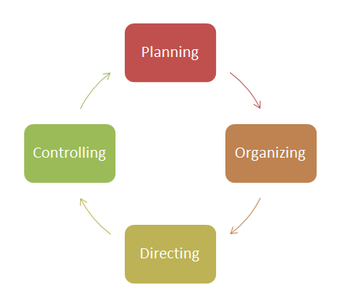
Definition of Management
The Management Process
Management functions include: Planning, organizing, staffing, leading or directing, and controlling an organization (a group of one or more people or entities) or effort for the purpose of accomplishing a goal.
There are several different resource types within management. Resourcing encompasses the deployment and manipulation of:
- Human resources
- Financial resources
- Technological resources
- Natural resources
Different type of Management Styles
There are different types of management styles, and the management process has changed over recent years. The addition of work teams and servant leadership has changed what is expected from managers, and what managers expect from their employees.
Traditional Management
There is a hierarchy of employees, low level management, mid-level management, and senior management. In traditional management systems, the manager sets out expectations for the employees who need to meet goals, but the manager receives the reward of meeting those goals.
Team Managment
In a team management arrangement the manager is a guiding hand to help the members of the team work together to solve problems but doesn’t dictate policy and the entire team receives the reward of meeting those goals.
Servant Management
With this approach, the manager helps supply resources the employees need to meet company goals. In servant leadership, the organization recognizes employees as experts in their field and work to help them work efficiently.
No matter which type of management style is used by an organization, the main objective of managers is to help employees reach company goals and maintain company standards and policies.
8.1.2: The Need for Management
Management is needed in order to facilitate a coordinated effort toward the accomplishment of an organization’s goals.
Learning Objective
Explain the purpose of management
Key Points
- Management in all business and organizational activities is the act of getting people together to accomplish desired goals and objectives using available resources efficiently and effectively.
- Good managers are needed to keep their organizations on track by ensuring that everything that’s being done is ethically geared toward providing what customers want.
- Good management is needed to inject motivation, creativity, discipline, and enthusiasm into areas in which they either don’t exist or they’re not necessarily wanted.
- People who work for managers must realize that it is their job to make their managers value them.
Key Term
- entrepreneurship
-
The art or science of innovation and risk-taking for profit in business.
Example
- IBM is still in business today due to the management skills of Louis V. Gerstner, Jr. When he arrived at IBM in April 1993, an active plan was in place to dis-aggregate the company. The prevailing wisdom of the time held that IBM’s core mainframe business was headed for obsolescence. The company’s own management was in the process of allowing its various divisions to rebrand and manage themselves — the so-called “Baby Blues. ” Gerstner reversed this plan, realizing from his previous experiences at RJR and American Express that there remained a vital need for a broad-based information technology integrator. His decision to keep the company together was the defining decision of his tenure, as this gave IBM the capabilities to deliver complete IT solutions to customers. Services could be sold as an add-on to companies that had already bought IBM computers, while barely profitable pieces of hardware were used to open the door to more profitable deals.
The Purpose of Management
The purpose of management is to serve customers. Yet, if one looks through most management books for a definition of management, 99.9 percent of the time the word customer will not be mentioned. This is astonishing because serving customers in order to obtain a profit is the crux of every business organization. Equally remiss is the fact that most definitions of management neatly filter out service in their descriptions of management.
Good managers constantly streamline their organizations toward making a sale. In other words, good managers are needed to keep their organizations on track by ensuring that everything that’s being done is ethically geared toward providing what customers want . In this regard, a good manager is responsible for reducing waste and ambiguity, keeping costs down, and motivating others to do the same. In the same vein, good managers regularly take educated risks and exercise good judgement (the basis of entrepreneurship). These risks include:
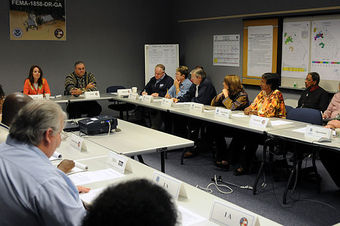
The Need for Management
Management is needed in order to coordinate the activities of a business and make sure all employees are working together toward the accomplishment of the organization’s goals.
- Trying new things;
- Successfully adjusting to constant change;
- Developing subordinates (good managers aren’t afraid of letting other people shine and, in fact, they encourage it);
- Improving their own skills.
The Need for Management
Management in all business and organizational activities is the act of getting people together to accomplish desired goals and objectives using available resources efficiently and effectively. Since organizations can be viewed as systems, management can also be defined as human action (including design) to facilitate the production of useful outcomes from a system. Therefore, management is needed in order to facilitate a coordinated effort toward the accomplishment of the organization’s goals.
Since most managers are responsible for more work than one person can normally perform, a good manager delegates and integrates his or her work (or the work of others). A manager does this by acting as a clear channel of communication within the business that he or she serves. Good management is needed to inject motivation, creativity, discipline, and enthusiasm into areas in which they either don’t exist or they’re not necessarily wanted.
The various functions of management are classified as:
- Planning
- Organizing
- Staffing
- Leading/Directing
- Controlling/Monitoring
- Motivation
Management is also responsible for the formation and implementation of business policies and strategies.
8.1.3: Trends in Management
Modern trends in management favor agile, iterative processes that focus on innovation, software development, and social impacts.
Learning Objective
Understand the evolving nature of management perspectives and strategies
Key Points
- Management is a constantly evolving field, with a wide variety of formal and informal approaches and perspectives.
- While new management perspectives are emerging everyday in manufacturing, technology, software, and social entrepreneurship, some of the most notable new perspectives are in software development.
- Scrum and agile management styles focus primarily on iteration and the capacity to build non-hierarchical work structures that empower growth and innovation without the rigidity of traditional management.
- Social entrepreneurship is a recent emergence in management, in which entrepreneurial management styles are being taken to the non-profit and community development sectors.
Key Terms
- iteration
-
The process of repeating a process in pursuit of incremental improvement.
- Scrum
-
A management philosophy predicated upon a feedback-driven iterative evolution of process.
Management is a rapidly evolving field. Even now startups all over the world are trying out new, innovative ways of looking at how to align their resources, how to make decisions, and what managerial approaches (or lack of managerial approaches) might yield the best culture for growth. It’s an intriguing time for management, and experimentation is constant.
When looking at new management approaches, it’s useful to consider the area in which these organizations operate. Software, non-profit, and entrepreneurship are all seeing substantial deviations from standard corporate management approaches.
Software
The two big words in software management over the past decade or two have been Scrum and Agile. Each of these approaches is a management philosophy equipped for rapid construction, iteration, and implementation.
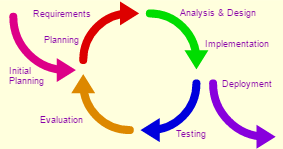
Iterative Development
The agile management philosophy is an adaptation of iterative management. The concept is fairly simple. All production of new and innovative products and services will require constant refinement and improvement through iterative experimentation.
Scrum has been around since the late 1980s, but not particularly prevalent until the early 21st century. Scrum is defined as a feedback-driven empirical approach that highlights transparency, inspection, and adaptation. In terms of values, scrum discards traditional hierarchy and promotes commitment, courage, focus, openness, and respect in a team-oriented, objectives-driven environment. In terms of structure, you’ll find three groups:
Development Team – This will be your functional specialists, all collaborating on a daily basis to construct a facet (or perhaps the entirety) of a new piece of software. In scrum, this is quite often cross-functional.
Scrum Master – A facilitator, this individual focuses on removing impediments and acting as a buffer between the team and external distractions (usually integration with other teams). The scrum master will also assess progress holistically, and ensure alignment with the scrum mentality.
Product Owner (PO) – The PO focuses on being a voice of the customer and the representation of stakeholders in the team environment. Stakeholders, in this context, represent anyone with an interest in the output of that team (primarily organizational owners and other teams). The PO is not a manager, but instead a bridge between the team and the external environment they operate in.
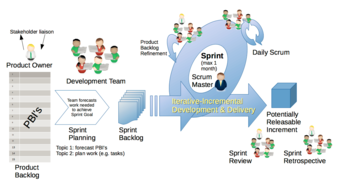
Scrum Framework
This is an excellent illustration of how scrum mentality works. It is intrinsically a horizontal management style, meaning there is no particular managerial presence. The idea is the that the process itself is self-sustaining in pursuit of agreed upon objectives via an iterative cycle of production.
Social Entrepreneurship
Utilizing the ever-evolving perspectives of start up companies and entrepreneurs, non-profit organizations and other community-oriented groups have begun replacing traditional management approaches with a more grassroots perspective. A key metric to a social entrepreneur isn’t profit but community impact, usually in areas such as poverty alleviation, health care, education, and community development. This management style is small, focused, innovation-driven, and non-hierarchical.
8.2: Functions of Managers
8.2.1: Planning and Decisions
Planning is the most fundamental of the five management functions; without it, none of the other functions can be carried out effectively.
Learning Objective
Identify planning as the most fundamental role of management
Key Points
- Planning is a way to project expectations, anticipate problems, and guide decision making.
- The planning process includes the selection of objectives, programs, or projects, and the policies and procedures needed to accomplish them.
- Plans exist at the strategic level, the program level, and the project level.
- It is important to review plans as conditions and circumstances change over time.
Key Terms
- vision
-
An ideal or a goal toward which one aspires.
- mission
-
A set of tasks that fulfills a purpose or duty; an assignment set by an employer.
- tactic
-
A maneuver or action calculated to achieve some end.
Example
- Revlon’s vision and mission statement are examples of how companies focus their attention on a common purpose to help make decisions. Its mission is to emerge as the leader in cosmetic and personal care throughout the world. Its vision is to satisfy the needs of their customers with glamour and excitement that they provide at an affordable price.
What Does Planning Have to Do with Management?
Management operates through various functions, often classified as:
- Planning
- Organizing
- Staffing
- Leading/Directing
- Controlling/Monitoring
Of the five functions, planning is the most fundamental; it is the management form from which the other four stem. To wit:
- A manager is ready to organize and staff only after goals and plans to reach the goals are in place.
- Likewise, the leading function (that is, influencing the behavior of people in the organization) depends on the goals to be achieved.
- Finally, in the controlling function, the determination of whether or not goals are being accomplished and standards are being met is based on the planning function. The planning function provides the goals and standards that drive the controlling function.
Therefore, plans are the seeds from which the organization functions. Even so, the need for planning is often apparent only after the fact. In the short run, planning is easy to postpone. The postponement of planning especially plagues labor-oriented, hands-on managers.
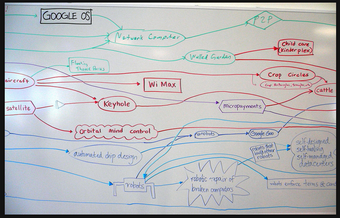
The Master Plan
Planning takes time, but its importance should not be overlooked.
What is Planning?
Planning is concerned with the future impact of today’s decisions. It is a technique of projecting expectations, anticipating problems, and guiding decision making.
The major purpose of planning is to focus the attention of all involved on a common purpose and to inform the decisions that needs to be made along the way. A plan helps to, and serves as a way to, measure the efficiency and effectiveness of an organization in accomplishing its strategic plans.
Companies often use SWOT analysis when planning. SWOT is a structured planning method used to evaluate the Strengths, Weaknesses, Opportunities, and Threats involved in a project or in a business venture. Of these four items, it is hardest for companies to control threats.
Some important planning terms, from most general to most specific, are:
- Vision: Nonspecific directional and motivational guidance for the entire organization. Top managers normally provide a vision for the business. It is the most emotional of the four.
- Mission: An organization’s reason for being. It is concerned with scope of the business and what distinguishes this business from similar businesses. Mission reflects the culture and values of top management.
- Objectives: Ideas that refine the mission and address key issues within the organization such as market standing, innovation, productivity, physical and financial resources, profitability, management, and worker performance and efficiency. They are expected to be general, observable, challenging, and untimed.
- Goals: Specific statements of anticipated results that further define the organization’s objectives. They are expected to be SMART: Specific, Measurable, Attainable, Rewarding, and Timed.
- Tactics: Who, what, when, where and how activities will take place to accomplish a goal.
The Anatomy of Plans
Plans can be created for projects, programs, or strategies. During the planning process, decision makers deliberately select objectives, programs, or projects, as well as the policies and procedures for accomplishing them within organizations. The creation of plans inevitably involves decision-making, because the planner must select from among considered alternatives.
Plans can one of the following forms:
- Prospectus
- Blueprint
- Proclamation
- Budget
- Campaign
Strategy Level, Program Level, and Project Plans
At the strategy level, plans articulate longer-term objectives and executive management’s vision of how the organization intends to achieve those objectives. In the process of determining a company’s strategic plan, three basic questions are answered:
- Where are we now?
- Where do we want to be?
- How do we get there?
Program level plans translate strategic plans within functional areas to coordinate activity across functions and up and down the layers of an organization. A budget is an example of a financial plan that formalizes strategic plans in monetary terms.
On the other hand, project plans are more granular and lay out the specific tactics that need to be followed by members of the organization in order to execute the strategy.
The courses of action in a project plan include:
- A calendar of events
- The division of tasks
- The required resources and scheduling
- Expectations for quality and completion of the work
Can Plans Change?
Regardless of the level of planning, plans must be re-examined regularly in the light of changing conditions and circumstances.
8.2.2: Organizing Tasks
Managers must organize to see their plans to fruition, thus assigning tasks to individuals and arranging them in an framework that allows decision making.
Learning Objective
Explain the nature of organization
Key Points
- Organization deals with issues like human resources, finance, and the establishment of priorities.
- Some of the characteristics associated with organization include: specialization and division of work; goal achievement; the grouping of individuals into departments; differentiated functions; and continuity.
- Organization helps companies achieve goals, make the best use of resources; grow; and focus on the betterment of their employees.
- Organizational design is a process that helps managers organize and align the structure, process, rewards, metrics, and talent with the business’ strategy.
Key Terms
- organizing
-
the management function of forming patterns of relationships among workers, and making optimum use of the resources required to enable the successful carrying out of plans
- matrix
-
Matrix management is a type of organizational management in which people with similar skills are pooled for work assignments.
- diversification
-
A corporate strategy in which a company acquires or establishes a business other than that of its current product
- resource
-
Something that one uses to achieve an objective. An examples of a resource could be a raw material or an employee.
Example
- A company might decide that a functional structure is best for them. In such a structure, the engineering department would be staffed only with software engineers. If a company decides that a matrix structure is best for it. An example would be a company that produces two products, “product a” and “product b”. Using the matrix structure, this company would organize functions within the company as follows: “product a” sales department, “product a” customer service department, “product a” accounting, “product b” sales department, “product b” customer service department, “product b” accounting department.
Organizing: An Overview
Once a plan has been created, a manager can begin to organize.
Organizing, in a company’s point of view, is the management function that usually follows planning. It involves the assignment of tasks, the grouping of tasks into departments, and the assignment of authority and allocation of resources across the organization. During the organizing process, managers co-coordinate employees, resources, policies and procedures to facilitate the goals set out in the plan.
Organizing is highly complex and can involve:
- Human resources
- Finance
- The establishment of priorities
The synchronization of all of these elements is important if results are to be obtained.
The Nature of Organization
The following are the important characteristics of organization.
Specialization and Division of Work
- The entire philosophy of organization is centered on the concepts of specialization and division of work.
- The division of work is assigning responsibility for each organizational component to a specific individual or group thereof. It becomes specialization when the responsibility for a specific task lies with a designated expert in that field.
- The efforts of the operatives are coordinated to allow the process at hand to function correctly. Certain operatives occupy positions of management at various points in the process to ensure coordination.
Orientation Towards Goals
Every organization has its own purposes and objectives. Organizing is the function employed to achieve the overall goals of the organization. Organization harmonizes the individual goals of the employees with overall objectives of the firm.
Composition of individuals and groups
- Individuals form a group and the groups form an organization. Thus, organization is the composition of individual and groups.
- Individuals are grouped into departments and their work is coordinated and directed towards organizational goals.
Differentiated functions
- The organization divides the entire work and assigns the tasks to individuals in order to achieve the organizational objectives; each one has to perform a different task and tasks of one individual must be coordinated with the tasks of others. Collecting these tasks at the final stage is called integration.
Continuity
- An organization is a group of people with a defined relationship in which they work together to achieve the goals of that organization. This relationship does not come to end after completing each task. Organization is a never ending process.
Benefits of Organization
Together, these characteristics:
Help to achieve organizational goals
- Organization is employed to achieve the overall objectives of business firms. Organization focuses attention of individuals objectives towards overall objectives.
Optimise the use of resources
- To make optimum use of resources such as men, material, money, machine and method, it is necessary to design an organization properly.
- Work should be divided and right people should be given right jobs to reduce the wastage of resources in an organization.
Aid managers in performing other managerial functions
- Additional planning, organizing, staffing, directing and controlling cannot be implemented without proper organization.
Facilitate growth and
diversification
- A good organization structure is essential for expanding business activity. Organization structure determines the input resources needed for expansion of a business activity similarly organization is essential for product diversification such as establishing a new product line.
Facilitate human treatment of employees
- Organization has to operate for the betterment of employees and must not encourage monotony of work due to higher degree of specialization.
- These days, organization has adapted the modern concept of systems approach based on human relations and it discards the traditional productivity and specialization approach.
Organizational Design: Helping Managers Organize
Organization design can be defined narrowly, as the process of reshaping organization structure and roles, or it can more effectively be defined as the alignment of structure, process, rewards, metrics and talent with the strategy of the business.
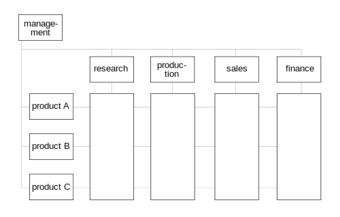
Organizational Design
This is one type of matrix organizational structure.
Organization design may involve strategic decisions, but is properly viewed as a path to effective strategy execution. The design process nearly always entails making trade-offs of one set of structural benefits against another.
Many companies fall into the trap of making repeated changes in organization structure, with little benefit to the business. This often occurs because changes in structure are relatively easy to execute while creating the impression that something substantial is happening. This often leads to cynicism and confusion within the organization.
More powerful change happens when there are clear design objectives driven by a new business strategy or forces in the market that require a different approach to organizing resources.
8.2.3: Staffing Roles
The managerial responsibility of staffing is an involved process of hiring, training, compensating, positioning, and assessing team members to enable operational success.
Learning Objective
List the various functions involved in staffing for managers
Key Points
- Building a team can make or break an operational process, and the manager is tasked with the majority of the responsibility in accomplishing this.
- The complexity of the modern job market, and the huge volume of qualified talent, makes the hiring process both an incredible opportunity and a complex filtering process.
- Once an employee is selected, training them for success and determining optimal compensation is key to getting the employee satisfied and up to speed.
- On the more strategic side of staffing, managers must appraise performance and identify gaps in the overall team’s execution.
- Staffing is only one of many responsibilities managers must attend to, giving some idea of the scope of responsibilities often shouldered by modern management.
Key Term
- performance appraisals
-
Employees have set objectives and milestones, and performance can be assessed via comparing actual outcomes to desired outcomes.
Managerial Staffing Responsibilities
One of the core functions of a manager is building and maintaining a team, which is accomplished through staffing responsibilities. Simply put, staffing is the managerial process of hiring, positioning, and overseeing employees. Often enough, human resources are both the most expensive and the most valuable assets a business has. Having internal talent can be a core competitive advantage, and bringing in the right people and positioning them for success is a core managerial responsibility.
Managers perform job analyses for each of the roles they intend to manage. This analysis includes hiring, training, compensation, performance appraisals, identification of gaps, and various compliance considerations.
Hiring
Finding talent is an enormous challenge and opportunity in today’s economy. With the diversity of skill sets, the high volume of applicants, and the growing complexity of organizational needs, managers are busier than ever when it comes to the hiring process. Many job postings will receive hundreds or even thousands of applicants, and filtering through this large applicant pool can be expedited by software solutions and the hiring of third parties to manage the hiring process.
Once a few key candidates are selected, there are a variety of important considerations prior to hiring. Managers often conduct one-on-one interviews, team interviews, personality tests, skill assessments, reference checks, and a variety of other alignment tests to ensure fit. Hiring is an expensive process, with expensive repercussions for mistakes. It is a core managerial function with substantial consequences, both positive and negative.
Training
Once a new employee is selected, it can take anywhere from a week to 6 months to truly get them up to speed. Every job is different, and every job has different training requisites. Investing both time and capital in preparing employees for success can create significant increases in value and return on investment, as well as empowering employees to grow and improve. Hiring employees without proper on-boarding can result in costly mistakes, role uncertainty, and ultimately job dissatisfaction.
Compensation
Compensation as a managerial responsibility isn’t just about salary (though certainly that’s an important component). Managers must understand what their employees need, and help to provide it via benefits, bonuses, training, and opportunities for professional growth. From health care to helping with a university degree, organizations have the opportunity to create employee loyalty as well as develop talent via strong staffing skills on behalf of management.
Performance Appraisals
Whether management does it on an ongoing basis, an annual basis, or a quarterly basis, most managers must consider the performance of their employees at one point or another. This can be done formally (and often is at larger firms) or informally, and must include both past performance and the expectations set at the beginning of the appraisal period. The employee must know before hand what it is they will be assessed on, and what the objectives and expectations are. It is also relatively common to attach incentives to performance appraisals, to provide value when value is provided.
Identifying Gaps
From a more strategic frame, managers must consider the overall process and objectives their work group is aiming to accomplish alongside what resources and skills must be present to do so. That means identifying where there are functional or skill gaps in a given team, and solving that problem. There are more solutions than just hiring full-time employees too. Managers may notice a skill gap that only requires 10 hours per week to fill. In this case, hiring a contractor on an hourly basis is lower risk and lower cost than hiring a new employee.
Compliance
Finally, managers must comply with a variety of legal aspects in collaboration with the HR department. Employee rights, unions, and other legal requirements from the governing bodies must be built into contracts and operations.
Conclusion
When combining all of these responsibilities, you have one facet of a manager’s overall responsibilities. This provides some scope to not only how much is involved in staffing, but how much can be involved in the role of management in general. Managers must also plan, organize, direct, and control.
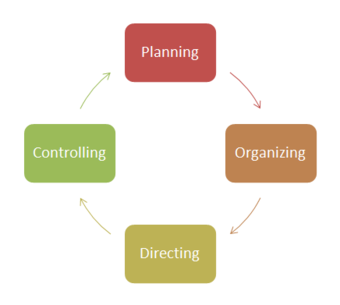
Management Process
Other managerial functions are highlighted in this diagram, in addition to the tasks involved in staffing.
8.2.4: Leading Teams
Certain leadership competencies help people become effective leaders; successful team leaders follow planning and implementation processes.
Learning Objective
Evaluate effective team leadership
Key Points
- Team leaders provide guidance, instruction, direction, and leadership to their respective teams. They must build teams and ensure that they work well together.
- A team leader reports to a project manager who oversees several teams.
- Effective team leaders possess six leadership competencies that translate to the success of their teams.
- Team leaders must be able to balance being a member of the team and a leader who manages the progress of the team.
Key Terms
- leading
-
the management function of determining what must be done in a situation and getting others to do it
- goal
-
a result that one is attempting to achieve
- leadership
-
The capacity of someone to lead.
- project manager
-
one who manages projects.
Example
- Here are examples of what employees view as good and bad team leaders. The members of Bob’s team think that he is a great team leader. All of them are impressed by his knowledge. But it is not his knowledge alone that makes him a good team leader. He also has the ability to “facilitate” discussion without imposing their own opinions. During the discussions je engages his team members with thought provoking “what if” scenarios. In the end, he is able to take multiple ideas and combine them into one concise statement reflective of all input. In contrast, John frustrates his team members. He sits in meetings and simply takes notes without doing anything to inspire creative thinking. He is only wants to make sure that the end results express his ideas. His team members feel dejected and useless.
Leading Teams
The Team Leader: an Overview
A team leader or team lead is someone (or in certain cases there may be multiple team leaders) who provides guidance, instruction, direction, and leadership to a group of other individuals (the team) for the purpose of achieving a key result or group of aligned results.
There are many elements that create, and are essential to be an effective leader who has the power to motivate a team and drive success. There is often a balancing act that the leader must manage between being a leader and a member while ensuring the goal is clear and obtainable.
A good team leader listens constructively to the membership and to the customer(s) of the results that the team is charged with delivering.
The Team Leader: Reporting Structure
The team lead reports to a project manager (overseeing several teams). The team leader monitors the quantitative and qualitative result that is to be achieved. The leader works with the team membership.
The team membership may not directly report or answer to the team leader (who is very often a senior member of the organization but may or may not be a manager), but would be expected to provide support to the team leader and other team members in achieving the team’s goals.
The Team Leader: Responsibilities
The responsibilities of a team lead vary greatly between organizations, but usually include some responsibility for team building and ensuring teamwork.
The term is used to emphasize the cooperative nature of a team, in contrast to a typical command structure, where the head of a team would be its commander.
The Team Leader: Leadership Competencies
There are six leadership competencies that are the building blocks to becoming an effective leader:
- Focus on the goal,
- Ensure a collaborative climate,
- Build confidence,
- Demonstrate sufficient technical know-how,
- Set priorities,
- Manage performance as described When Teams Work Best by LaFasto and Larson.
Does an effective team leader both merge into the group as a member of the team and also maintain a leadership role? And if so, how?
A leader is the key player in the game that is comprised of challenge and risk. Therefore, an effective team leader must be both a component to the team and also a leader to manage the team’s progress.
The leader cannot possibly be competent in every area without being engaged in the team. The leader must know each member and the team as a whole in order to bring them all together and create a process that is open, productive, and promotes confidence.
An effective leader uses each member’s contributions and energy to focus on a common goal.
Essentially, a leader’s job is to add importance to the team’s effort, which cannot be done without being a member.
It is very common for a team leader to be in the dark about their team and the everyday operations. This is a consequence of a leader’s disengagement and lack of membership with the team.
Moreover, the team’s contention usually gives birth at this point and lends itself to decreased productivity and satisfaction. An effective leader needs to be able to pinpoint problems and praise excellence within the group, which cannot be done from the sidelines.
The leader is a part of the overall process; therefore, a relationship naturally exists. However, it is up to the leader whether to nurture that relationship or minimize its importance.
The team leader must understand the team’s vision and clearly define the goal to guarantee success and member loyalty. One cannot lead a team without knowing the purpose and goal of the team. The team leader creates a collaborative climate to ensure that the best thinking and ideas of the team are represented. Again, a wholesome climate cannot be established without knowing the members and becoming engaged in the team.
The foundation of a highly motivated and successful team is the members’ understanding and relevance of their goal. An effective leader’s trust in the team goal is vital to the member’s commitment.
The members become isolated and discouraged when the leader’s investment is minimal. Team members want the opportunity to prove their value and worth to the goal and the leader. The leader must be involved and a member of the team to effectively influence the members’ productivity and function in the grand scheme of things.

Leading Teams
Team Leadership
8.2.5: Knowledge Management
Organizations use knowledge management to identify, create, represent, distribute, and enable strategy and process.
Learning Objective
Explain the importance and recent developments in Knowledge Management (KM)
Key Points
- Knowledge management typically focuses on specific organizational objectives.
- Criteria have been developed that help organizations measure the benefits they receive from knowledge management.
- Technology plays a large role in the development of knowledge management tools.
- Knowledge management efforts tend to overlap those of organizational learning and are, in fact, seen as an enabler of organizational learning.
Key Terms
- management development
-
the process by which company employees responsible for overseeing departments or the whole company learn and improve their skills not only to benefit themselves but also their employing organizations
- artificial intelligence
-
The branch of computer science dealing with the reproduction or mimicking of human-level intelligence, self-awareness, knowledge, conscience, thought in computer programs.
- groupware
-
software designed to be used collaboratively by multiple users on a network
- organizational learning
-
In Organizational development (OD), learning is a characteristic of an adaptive organization, i.e., an organization that is able to sense changes in signals from its environment (both internal and external) and adapt accordingly.
Example
- Here are examples of the knowledge management tools various companies use: At Xerox and World Bank, groups meet regularly to share knowledge and learn from each other. Accenture and Ernst & Young use databases of codified knowledge assets (known as knowledge repositories). Hewlett-Packard and Microsoft use expertise directories.
Knowledge Management
Knowledge management (KM) comprises a range of strategies and practices used in an organization to identify, create, represent, distribute, and enable the adoption of insights and experiences. Such insights and experiences comprise of knowledge, either embodied in individuals or embedded in organizations, such as processes or practices. Once an organization has the framework in place that knowledge management provides, it can design its strategy, structure and processes in such a way that it uses what it knows to. This, in turn, creates value for its customers and the community as a whole.
Organizational Functions of Knowledge Management and Their Benefit
Knowledge management efforts typically focus on organizational objectives such as:
- Improved performance
- Competitive advantage
- Innovation
- The sharing of lessons learned
- Integration
- Continuous improvement of the organization
As a result, companies benefit as they are able to:
- Develop new products and services that add value to their customers (innovation, competitive advantage)
- Improve the value of their existing products (the sharing of lessons learned, improved performance, competitive advantage)
- Control costs and promote reuse (integration, continuous improvement of the organization, the sharing of lessons learned);
- Respond to environmental changes faster and experience less uncertainty (the sharing of lessons learned which can provide general knowledge about the environment)
How does an Organization Know it is Receiving these Benefits?
Here are a few of the criteria for measuring the efficacy of a knowledge management strategy:
- How long it takes to respond: This metric includes the speed in which the organization responds to customer needs, requests, or problems; brings a new product or service to market; and enters new markets.
- How much knowledge is reused: This metric measures how often employees access and use knowledge assets and avoid “re-inventing the wheel”.
- How much is made from new products: This metric loos at the revenue from products that have been developed recently or are a certain number of years old.
- How satisfied and empowered employees are and feel: This metric measure the ability of the organization to hire talented staff, the ability of the organization to keep talented staff, and the amount of influence these knowledgeable staff members have.
Facets of Knowledge Management
Early KM technologies included online corporate yellow pages as expertise locators and document management systems. Combined with the early development of collaborative technologies (in particular Lotus Notes), KM technologies expanded in the mid-1990s. Subsequent KM efforts leveraged semantic technologies for search and retrieval and the development of e-learning tools for communities of practices (Capozzi 2007). Knowledge management systems can thus be categorized as falling into one or more of the following groups:
- Groupware
- Document management systems
- Expert systems
- Semantic networks
- Relational and object oriented databases
- Simulation tools
- Artificial intelligence (Gupta & Sharma 2004)
More recently, the development of social computing tools (such as bookmarks, blogs, and wikis) have allowed more unstructured, self-governing or ecosystem approaches to the transfer, capture and creation of knowledge, including the development of new forms of communities, networks.
Software tools in knowledge management are a collection of technologies and are not necessarily acquired as a single software solution. Furthermore, these knowledge management software tools have the advantage of using the organization’s existing information technology infrastructure.
Organizations and business decision makers spend a great deal of resources and make significant investments in the latest technology, systems and infrastructure to support knowledge management. It is imperative that these investments are validated properly, made wisely, and that the most appropriate technologies and software tools are selected or combined to facilitate knowledge management.
Knowledge Management in Education and in Corporations
An established discipline since 1991 (see Nonaka 1991), KM includes courses taught in the fields of business administration, information systems, management, and library and information sciences (Alavi & Leidner 1999). More recently, other fields have started contributing to KM research, such as information and media, computer science, public health, and public policy. Many large companies and non-profit organizations have resources dedicated to internal KM efforts, often as a part of their business strategy, information technology, or human resource management departments (Addicott, McGivern & Ferlie 2006). Several consulting companies also exist that provide strategy and advice regarding KM to these organizations.

Knowledge Management
The Knowledge Spiral
8.2.6: Controlling Activities
Controlling is a core managerial function defined by observing and optimizing operational processes.
Learning Objective
Understand the managerial process of control
Key Points
- Organizations are essentially a combination of processes, each of which benefits from managerial control.
- Control is simply the activity of observing a given organizational process, measuring the performance compared to a previously established metric, and improving it where possible.
- At the upper-managerial level, control revolves around setting strategic objectives in the short and long term, as well as measuring success.
Key Term
- iterate
-
Repeating processes in order to identify and incorporate improvements.
Controlling
One facet of management is called controlling, and it is an important piece of the management puzzle. Control is observing current (and projecting future) processes and operational systems in order to avoid mistakes, identify improvements, ensure objectives are accomplished, and consider the big picture. Organizations are made up of operational systems, each of which can be iterated upon and optimized for improved performance.
The Four Elements of Control
The process of control can usually be divided into the following four components:
- The process to be controlled – This is simply the aspect (or entirety) of a process being measured. For example, let’s say getting customers to a website via online ads.
- The sensor – The sensor is the component that measures the condition being controlled. In this case, Google analytics will provide the information of how many individuals see the ad and how many come to the website as a result.
- The comparator – The comparator is the expectation the actual results will be compared to. In our example, let’s say we’re looking for 5% of people who see the ad to come to the website.
- The activator – The activator is what will intervene to improve the process, if necessary. Let’s say overall only 2% of people clicked the ad and came to the website. The activator will be the tactical changes management will take to get the current operational efficiency improved to the desired level.
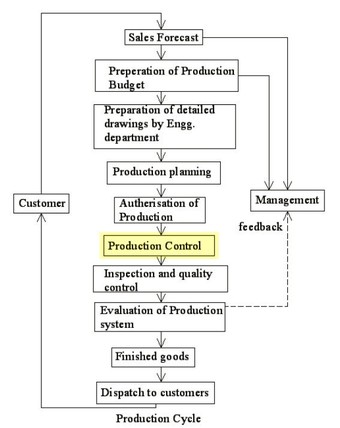
Production Control
This chart demonstrates the control process chronologically over time, and the way in which management can actively impact the execution of a given operation.
Strategic Control
The above example relates primarily to an operational process. Optimizing operational processes is often done at the mid-managerial level. At the upper managerial level, strategic control is a similar process in a broader context. Strategic control pertains to four elements as well:
- Mission statements/vision statements/operational plans – the identification and communication of the strategic outcomes desired by the organization
- Short and long-term objectives – the description of the strategic activities to be carried out (attached to specific managed resources) in pursuit of the above statements
- Measurement and Tracking – the creation and implementation of a reporting system to track the progress and success of the objectives identified
- Enabling Iteration – Once the operations are in place, the organization will begin pursuing the noted objectives. At this point, the organization needs systems to change and evolve the process for improvement.
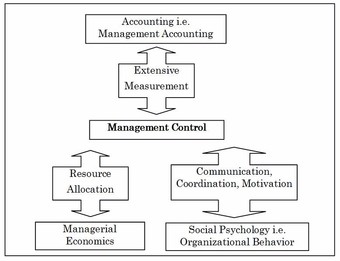
Management Control Systems
This chart demonstrates the relationship between various work groups in the controlling process.
8.2.7: Customer Experience Management
Customer experience management focuses the operations and processes of a business around the need of the individual customer.
Learning Objective
Explain the difference between Customer Experience Management (CEM) and Customer Relationship Management (CRM)
Key Points
- The goal of customer experience management (CEM) is to move customers from satisfied to loyal and then from loyal to advocates.
- Customer experience solutions optimize the end-to-end customer experience.
- Customer experience management differs from customer relationship management is that the former focuses on customer need and desire.
Key Terms
- business model
-
The particular way in which a business organization ensures that it generates income, one that includes the choice of offerings, strategies, infrastructure, organizational structures, trading practices, and operational processes and policies.
- customer relationship management
-
Customer relationship management (CRM) is a widely implemented model for managing a company’s interactions with customers, clients, and sales prospects. It involves using technology to organize, automate, and synchronize business processes—principally sales activities, but also those for marketing, customer service, and technical support.
Example
- The customer experience has emerged as the single most important aspect in achieving success for companies across all industries (Peppers & Rogers, 2005). For example, Starbucks spent less than $10MM on advertising from 1987 to 1998, yet added over 2,000 new stores to accommodate growing sales. Starbucks’ popularity is based on the experience that drove its customers to highly recommend their store to friends and family.
What Is Customer Experience Management (CEM)?
Customer experience management (CEM) is a strategy that focuses the operations and processes of a business around the needs of the individual customer. Companies are focusing on the importance of the experience. Jeananne Rae says that companies are realizing that “building great consumer experiences is a complex enterprise, involving strategy, integration of technology, orchestrating business models, brand management and CEO commitment.”
According to Bernd Schmitt, “the term ‘customer experience management’ represents the discipline, methodology and/or process used to comprehensively manage a customer’s cross-channel exposure, interaction and transaction with a company, product, brand or service.”
The goal of customer experience management is to move customers from satisfied to loyal and then from loyal to advocate.

In-N-Out Burger
University Tower in Irvine, next to the University of California. This office building is home to the corporate headquarters of In-N-Out Burger. The In-N-Out restaurant chain has developed a highly loyal customer base and has been rated as one of the top fast food restaurants in several customer satisfaction surveys.
Customer experience solutions provide strategies, process models, and information technology to design, manage, and optimize the end-to-end customer experience process.
Why Isn’t Customer Relationship Management Enough?
Traditionally, managing the customer relationship has been the domain of customer relationship management (CRM). However, CRM strategies and solutions are designed to focus on product, price, and enterprise process, with minimal or no focus on customer need and desire.
The result is a sharp mismatch between the organization’s approach to customer expectations and what customers actually want, resulting in the failure of many CRM implementations.
Where CRM is enterprise-focused and designed to manage customers for maximum efficiency, CEM is a strategy that focuses the operations and processes of a business around the needs of the individual customer.
Companies are focusing on the importance of the experience and, as Jeananne Rae notes, realizing that “building great consumer experiences is a complex enterprise, involving strategy, integration of technology, orchestrating business models, brand management and CEO commitment” (2006).
8.3: Types of Management
8.3.1: Management Levels: A Hierarchical View
An organization can have many different managers, across many different titles, authority levels, and levels of the management hierarchy.
Learning Objective
Recognize the difference between low-level, middle-level and top-level management
Key Points
- The three levels of management typically found in an organization are low-level management, middle-level management, and top-level management.
- Top-level managers are responsible for controlling and overseeing the entire organization.
- Middle-level managers are responsible for executing organizational plans which comply with the company’s policies. These managers act at an intermediary between top-level management and low-level management.
- Low-level managers focus on controlling and directing. They serve as role models for the employees they supervise.
Key Terms
- middle management
-
company employees that are accountable for controlling and overseeing a department
- top management
-
company employees responsible for controlling and overseeing the entire organization
- board of directors
-
A group of people, elected by stockholders, to establish corporate policies, and make management decisions.
- manager
-
A person whose job is to manage something, such as a business, a restaurant, or a sports team.
- hierarchy
-
Any group of objects ranked so that every one but the topmost is subordinate to a specified one above it.
Example
- Examples of top-level managers include a company’s board of directors, president, vice-president and CEO; examples of middle-level managers include general managers, branch managers, and department managers; examples of low-level managers include supervisors, section leads, and foremen.
Management Levels: An Overview
Most organizations have three management levels:
- Low-level managers;
- Middle-level managers; and
- Top-level managers.
These managers are classified in a hierarchy of authority, and perform different tasks. In many organizations, the number of managers in every level resembles a pyramid.
Below, you’ll find the specifications of each level’s different responsibilities and their likely job titles.
Top-level managers
The board of directors, president, vice-president, and CEO are all examples of top-level managers.
These managers are responsible for controlling and overseeing the entire organization. They develop goals, strategic plans, company policies, and make decisions on the direction of the business.
In addition, top-level managers play a significant role in the mobilization of outside resources.
Top-level managers are accountable to the shareholders and general public.
Middle-level managers
General managers, branch managers, and department managers are all examples of middle-level managers. They are accountable to the top management for their department’s function.
Middle-level managers devote more time to organizational and directional functions than top-level managers. Their roles can be emphasized as:
- Executing organizational plans in conformance with the company’s policies and the objectives of the top management;
- Defining and discussing information and policies from top management to lower management; and most importantly
- Inspiring and providing guidance to low-level managers towards better performance.
Some of their functions are as follows:
- Designing and implementing effective group and intergroup work and information systems;
- Defining and monitoring group-level performance indicators;
- Diagnosing and resolving problems within and among work groups;
- Designing and implementing reward systems supporting cooperative behavior.
Low-level managers
Supervisors, section leads, and foremen are examples of low-level management titles. These managers focus on controlling and directing.
Low-level managers usually have the responsibility of:
- Assigning employees tasks;
- Guiding and supervising employees on day-to-day activities;
- Ensuring the quality and quantity of production;
- Making recommendations and suggestions; and
- Upchanneling employee problems.
Also referred to as first-level managers, low-level managers are role models for employees. These managers provide:
- Basic supervision;
- Motivation;
- Career planning;
- Performance feedback; and
- Staff supervision.
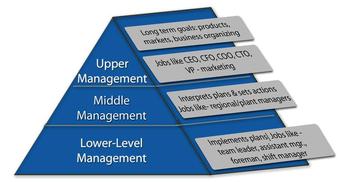
Management Levels
Hierarchical view of management in organizations
8.3.2: Management Areas: A Functional View
Organizational management is often approached by identifying business functions and assigning leadership to those functions.
Learning Objective
Understand management areas and why they are often viewed from a functional perspective
Key Points
- Organizations are essentially a group of different functions, aligned to create a specific product or service. Assigning managers to different functional areas is a popular approach to business management.
- Viewing organizational management from this perspective is useful in ensuring each function has a specialist in place with the knowledge and expertise to make sound decisions.
- Some common management areas include marketing, finance, IT, sales, human resources, and legal.
- Taking a look at an organizational chart is useful in understanding how management areas are commonly identified from a functional view.
Key Terms
- organizational chart
-
A chart outlining the structure of an organization and the way in which the different roles, functions, and departments interact with one another.
- best practices
-
The specific professional activities that produce near optimal results.
Understanding Functional Management Areas
Businesses are comprised of a variety of different tasks which, when coordinated properly, create value through producing products and/or services. Each of these different tasks, or functions, require management and alignment. One approach to management is assigning leadership roles with authority and accountability over these different tasks, or management areas.
This view creates management positions with authority over a given functional department. These management areas can span a wide variety of skills and functions, but the most recognizable and common include marketing, finance, human resources, operations, software development, and IT.
This functional view emphasizes managers who are specialists in their fields who are also capable of leading teams, balancing budgets, and thinking tactically (and sometimes strategically, at the upper levels).
The Role of a Functional Management
Functional management is focused on the execution of a specific organizational task within functional areas, through organizing and leading an organization’s talent in a given field. Functional managers have a high level of technical knowledge and skills relative to the area they manage and focus their efforts on achieving best practices.
Let’s quickly explore an example of a functional manager to clarify the role and responsibilities. A human resources manager in an organization would be expected to oversee all operations within the scope of human resources. At a medium or larger sized organization, this could include managing specialists in payroll, recruitment, talent development, legal, and a variety of other specializations within the scope of a human resources team.
The manager shouldn’t execute each specific task, but instead understand what is required to complete these tasks. The manager must have the broad technical knowledge required to ensure each individual within that functional team has the skills, resources, and alignment necessary to effectively carry out these functions.
Illustrating Functional Management
A simple way to understand how this all plays out in an organization is a simple organizational chart (org chart, as they are commonly referred to). By taking a look at how the departments are divided, it becomes fairly easy to assume what types of management areas exist from a functional view. As a result, it’s fairly common to receive an org chart when you start a job (particularly at larger companies), to understand who reports to whom, and regarding what tasks.
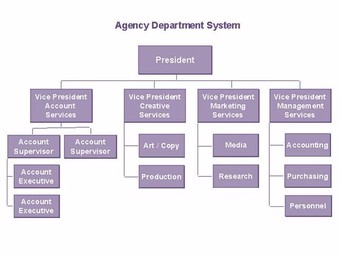
Organizational Chart
This is a simple example of an organizational chart, in this case at an advertising agency. By looking at each functional area, and considering how it relates to broader functional areas, it becomes clear how management areas are divided from a functional perspective.
8.4: Decision Making
8.4.1: Observation: Framing the Problem
A frame in social theory consists of a schema of interpretation that individuals rely on to understand and respond to events.
Learning Objective
Apply the framing problem to decision making
Key Points
- People do not look at an event and then “apply” a frame to it; people constantly project into the world around them the interpretive frames that allow them to make sense of it.
- The basis of framing is the selective influence of information on a person’s decision- making process based on internal heuristics.
- Framing can affect the outcome (i.e., the choices one makes) of choice problems, to the extent that several of the classic axioms of rational choice do not hold. This led to the development of the prospect theory as an alternative to rational choice theory.
- Depending on how the information is presented, framing can lead to entirely rational individuals making completely different decisions based on the way information is presented. Numerous experiments have shown this to be the case.
- Generally, people prefer absolute certainty in situations where information is positively framed, while they prefer risk-seeking behavior when decisions are framed in negative terms.
Key Terms
- Rational choice theory
-
Rational choice theory, also known as choice theory or rational action theory, is a framework for understanding and often formally modelling social and economic behavior. Rationality, interpreted as “wanting more rather than less of a good,” is widely used as an assumption of the behavior of individuals in microeconomic models and analysis and appears in almost all economics textbook treatments of human decision making.
- schema
-
An outline or image universally applicable to a general conception, under which it is likely to be presented to the mind.
- heuristics
-
A mental shortcut that may not always yield desired results.
Example
- Tversky and Kahneman’s (1981) Asian disease experiment demonstrated the problem with framing. Two groups of subjects were given a fictional scenario with the same information, presented in different ways. An unusual disease from Asia was going to hit the United States and kill 600 people. Group A were given two alternatives: either save 200 people for certain; or save 600 with a 1/3 probably, with a 2/3 chance that all will die. Group B was given the following choices: 400 die for certain; or nobody dies with a 1/3 probability, and a 2/3 chance and all die. Group A overwhelmingly selected the first option, while Group B chose the latter option in their case. This experiment demonstrated the huge effect that framing can have on otherwise rational decision making.
A frame in social theory consists of a schema of interpretation that individuals rely on to understand and respond to events. In other words, people build a series of mental filters through biological and cultural influences and use those filters to understand the world. Their choices are influenced by their frames.
Explanation
When one seeks to explain an event, the understanding often depends on the individual’s frame. If a friend rapidly closes and opens an eye, we will respond very differently depending on whether we attribute this to a purely “physical” frame (s/he blinked) or to a social frame (s/he winked).
Though the former might result from a speck of dust (resulting in an involuntary and not particularly meaningful reaction), the latter would imply a voluntary and meaningful action (e.g., to convey humor to an accomplice).
People do not look at an event and then “apply” a frame to it; people constantly project into the world around them the interpretive frames that allow them to make sense of it. People only shift frames when incongruity calls for a frame shift. In other words, people only become aware of the frames that they already use when something forces them to replace one frame with another.
Framing is so effective because it is a heuristic, or a mental shortcut that may not always yield desired results and is seen as a “rule of thumb.” According to Susan T. Fiske and Shelley E. Taylor, human beings are by nature “cognitive misers,” meaning they prefer to do as little thinking as possible. Frames provide people a quick and easy way to process information. Hence, people will use the previously mentioned mental filters (a series of which is called a “schema”) to make sense of incoming messages. This gives the sender and framer of the information enormous power to use these schemas to influence how the receivers will interpret the message.
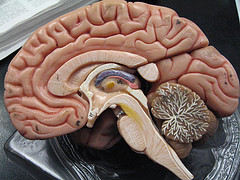
The Brain’s Heuristics for Emotions
Emotions appear to aid the decision-making process.
The Framing of Problems
Amos Tversky and Daniel Kahneman have shown that framing can affect the outcome (i.e., the choices one makes) of choice problems, to the extent that several of the classic axioms of rational choice do not hold. This led to the development of the prospect theory as an alternative to rational choice theory.
The context or framing of problems adopted by decision makers results in part from extrinsic manipulation of the decision options offered, as well as from forces intrinsic to decision makers (e.g., their norms, habits, and unique temperament).
Experimental Demonstration
Tversky and Kahneman (1981) demonstrated systematic reversals of preference when the same problem is presented in different ways, for example, in the Asian disease problem. Participants were asked to “imagine that the U.S. is preparing for the outbreak of an unusual Asian disease, which is expected to kill 600 people. Two alternative programs to combat the disease have been proposed. Assume the exact scientific estimate of the consequences of the programs are as follows. “
The first group of participants was presented with a choice between programs: In a group of 600 people, Program A: “200 people will be saved;” Program B: “there is a one-thirds probability that 600 people will be saved, and a two-thirds probability that no people will be saved. ” Of participants, 72% preferred program A (the remainder, 28%, opted for program B).
The second group of participants was presented with the choice between the following: In a group of 600 people, Program C: “400 people will die” Program D: “there is a one-third probability that nobody will die, and a two-thirds probability that 600 people will die”
In this decision frame, 78% preferred program D, with the remaining 22% opting for program C.
Programs A and C are identical, as are programs B and D. The change in the decision frame between the two groups of participants produced a preference reversal: When the programs were presented in terms of lives saved, the participants preferred the secure program, A (= C). When the programs were presented in terms of expected deaths, participants chose the gamble D (= B).
Absolute and Relative Influences
Framing effects arise because one can frequently frame a decision using multiple scenarios, wherein one may express benefits either as a relative risk reduction (RRR), or as absolute risk reduction (ARR). Extrinsic control over the cognitive distinctions (between risk tolerance and reward anticipation), adopted by decision makers, can occur through altering the presentation of relative risks and absolute benefits.
People generally prefer the absolute certainty inherent in a positive framing-effect, which offers an assurance of gains. When decision options appear framed as a likely gain, risk-averse choices predominate.
A shift toward risk-seeking behavior occurs when a decision maker frames decisions in negative terms or adopts a negative framing effect.
8.4.2: Developing Alternate Plans of Action
It is important to develop and consider alternatives for dealing with any given situation.
Learning Objective
Explain the benefits of decision planning
Key Points
- After defining a problem, decision makers must take steps to identify alternative actions to respond to it.
- Developing alternatives requires decision makers to gather data, interpret that data, and brainstorm to come up with multiple solutions that can be compared and ranked.
- Creative thinking, and thinking out of the box, are key to coming up with a full range of alternatives.
Key Term
- brainstorming
-
A method of problem solving in which members of a group contribute ideas spontaneously.
Example
- If a company has an opportunity to enter a new geographical market, managers must choose the best way to do so. Should they enter in a licensing agreement? Or make a franchise agreement with a local franchisee? Or enter the market directly by acquiring existing operations within that target market? Managers must collect data on the market, analyze this data, and consider the advantages and disadvantages of each possible alternative.
Decision Planning
Making a decision without planning is fairly common, but does not often end well. Planning allows for decisions to be made comfortably and in a smart way. Planning also makes decision making much simpler . Any decision will get four benefits out of planning:

Flowchart Diagram
Simplistic decision diagram of when to create Wikipedia articles
- Planning establishes independent goals. It is a conscious and directed series of choices.
- Planning provides a standard of measurement. It is a measurement of whether you are going toward or further away from your goal.
- Planning converts values to action. You think twice about the plan and decide what will help advance your plan best.
- Planning allows for limited resources to be committed in an orderly way. Always govern the use of what is limited to you (e.g., money, time, and so on).
Developing Alternatives
The need to make a decision arises because there are many available alternatives. Hence, the next step after defining the main problem would be to identify the alternatives available for that particular situation.
Gathering data helps decision makers have actual evidence that will aid them in coming up with a solution. Brainstorming helps them develop alternatives. Coming up with more than one solution enables decision makers to see which one can actually work.
While brainstorming, individuals do not have to restrict themselves to thinking about the very obvious options. Instead, they can use their creative skills and come up with alternatives that may look a little irrelevant. This is important because sometimes solutions can come from these out-of-the-box ideas.
8.4.3: Analyzing the Options
Evaluating alternatives is an important and difficult step of the decision-making process.
Learning Objective
Analyze the misleading effects of evaluating alternatives
Key Points
- The normative approach to analyzing decision-making assumes rational decision-makers with well-defined preferences. On the other hand, the descriptive approach is based on empirical observations and experiments. Finally, the prescriptive enterprise develops methods to improve decision making.
- Whichever approach is taken, there is always the problem that misleading effects can lead to a bad decision. These effects can take the form of heuristics, which help in some situations and not in others.
- Decision making often includes the need to assign a reason to justify the decision.
- – Subjective models – people create misleading and incorrect decision making models
- – Focusing illusion – people neglect important outcomes because they are focused on other, more obvious aspects
- – Selective search for evidence – focusing on facts that support certain conclusions
- – Premature termination of search for evidence
- – Selective perception – screening out of information not thought to be important
- – Wishful thinking – our desire to see things in a positive light may distort our perception
- – Recency – placing more emphasis on more recent events
- Repetition bias – believing that which we hear most often
- – Group think – pressure to conform to the opinions of a group
- – Source credibility bias
- – Anchoring – accepting initial information as factual and basing subsequent opinions around that
- – Over confidence
- – Recallability trap – a distorted ability to recall life events objectively
- – Outguessing randomness trap – imagination of patterns where none exist
Key Term
- Prescriptive
-
Prescriptive analytics automatically synthesizes big data, mathematical sciences, business rules, and machine learning to make predictions and then suggest decision options to take advantage of the predictions.
Example
- Evaluating alternatives is an important and difficult step of the decision-making process, and involves discerning the advantages and disadvantages of each option, and ultimately ranking them.
Evaluating the alternatives can be said to be one of the most important stages of the decision-making process . This is the stage where you have to analyze each alternative that you have come up with. You have to find out the advantages and disadvantages of each option. This can be done with the research you have done on that particular alternative. At this stage, you can also filter out the options that you think are impossible or do not serve your purpose. Rating each option with a numerical digit would also help in the filtration process.
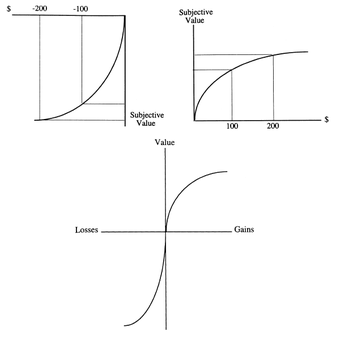
Money and Decision Making
Relation between (monetary) gains and losses and their subjective value.
Misleading Effects
But even respecting the considerations above, there still might be problems in making the “right” decision because of different misleading effects, which mainly arise because of the constraints of inductive reasoning. This generally means that our model of a situation or problem might not be ideal to solve it in an optimal way. Biases can creep into our decision-making processes. Many different people have made a decision about the same question (e.g., “Should I have a doctor look at this troubling breast cancer symptom I’ve discovered? ” “Why did I ignore the evidence that the project was going over budget? “) and then craft potential cognitive interventions aimed at improving decision-making outcomes.
At every step of decision making, misperceptions based on incorrect input, biases, lack of information, and other traps can corrupt the choices we make. We are particularly vulnerable to traps involving uncertainty because most of us are not good at judging chances. Complex and important decisions are the most prone to distortion because they tend to have many assumptions and estimates, as well as influence by misaligned parties.
Research has shown that over time we develop unconscious routines to cope with the inherent intricacy in most decision making. These thinking patterns, known as heuristics, can help us in many situations. We are nimble at judging distance, time, weight, and volume. For example, in judging distance our minds rely on a heuristic that associate clearness with closeness. The better the visibility of an object, the closer it must be.
But some heuristics can muddle our thinking with biases and irrational preferences. The danger with these traps is that they are invisible to most of us.
Justification in Decision Making
Decision making often includes the need to assign a reason to justify the decision. This factor is illustrated by an experiment by A. Tversky and E. Shafir in 1992. For this experiment, a very attractive vacation package was offered to a group of students who had just passed an exam. It was also offered to another group of students who had just failed the exam and had the chance to rewrite it over their vacation. All students had the option to buy the ticket straight away, to stay at home, or to pay and keep the option open until they would get their results. Even though the actual exam result did not influence the decision, it was required in order to provide a rationale.
8.4.4: Putting the Plan to Work
After analyzing the options, the next step is the implementation of a solution.
Learning Objective
Outline the key steps in the decision making process
Key Points
- Implementation is a difficult and important step, as decisions made need to be carried out.
- It is important that all the people involved in implementation know about the implications.
- The decisive actions are taken, and additional actions are taken to prevent any adverse consequences from becoming problems and starting both systems (problem analysis and decision making) all over again.
Key Terms
- planning
-
The act of formulating a course of action, or of drawing up plans.
- contingency planning
-
the process of forming an alternative set of actions in case the original set of intended actions fails
Decision Making
Steps in the decision making process include:
- Objectives must first be established.
- Objectives must be classified and placed in order of importance.
- Alternative actions must be developed.
- The alternatives must be evaluated against all the objectives.
- The alternative that is able to achieve all the objectives is the tentative decision.
- The tentative decision is evaluated for more possible consequences.
The decisive actions are taken, and additional actions are taken to prevent any adverse consequences from becoming problems and starting both systems (problem analysis and decision making) all over again . There are steps that are generally followed that result in a decision model that can be used to determine an optimal production plan. In a situation featuring conflict, role-playing is helpful for predicting decisions to be made by the parties involved.
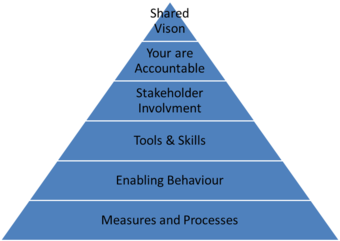
SYSTEM
The SYSTEM pyramid explains the key leadership attributes for strategic thinking.
Decision Planning
Making a decision without planning is fairly common, but does not often end well. Planning allows for decisions to be made comfortably and in an intelligent way. Planning also simplifies the decision-making process. Any decision will get four benefits out of planning:
- Planning establishes independent goals. It is a conscious and directed series of choices.
- Planning provides a standard of measurement. It is a measurement of whether you are going toward or further away from your goal.
- Planning converts values to action. You think twice about the plan and decide what will help advance your plan best.
- Planning allows for limited resources to be committed in an orderly way. Always govern the use of what is limited to you (e.g., money, time, and so on).
8.4.5: Closing the Feedback Loop
Feedback is the process where past information influences the a similar phenomenon in the present or future.
Learning Objective
Explain the role of the feedback loop in decision making and the different types of feedback associated with it
Key Points
- It is important to note that information by itself is not feedback unless it is translated into action.
- Feedback is also a synonym for feedback signals, feedback mechanisms, and feedback loops.
- The making and implementation of a decision is not the end of the decision-making process. Regular monitoring, and measuring the results of implementation against expected standards from an early stage will help close the feedback loop by altering decisions, if necessary.
Key Terms
- Feedback mechanism
-
the action or means used to subsequently modify the gap in a feedback loop
- Feedback loop
-
Feedback is a process in which information about the past or the present influences the same phenomenon in the present or future. As part of a chain of cause-and-effect that forms a circuit or loop, the event is said to “feed back” into itself. The feedback loop is the complete causal path that leads from the initial detection of the gap to the subsequent modification of the gap.
- Feedback signal
-
the measurement of the actual level of the parameter of interest in a feedback loop
Example
- Suppose a company decides to produce 200 widgets a day based on the expected demand. Once this plan is put into action, the company undertakes regular monitoring and discovers that only 150 widgets are being sold. The company can then alter their production process to ensure that they are not overproducing. If done early, this feedback loop ensures that a correct decision is ultimately made.
Feedback is a process in which information about the past or the present influences the same phenomenon in the present or future. As part of a chain of cause-and-effect that forms a circuit or loop, the event is said to “feed back” into itself.
Ramaprasad (1983) defines feedback generally as “information about the gap between the actual level and the reference level of a system parameter which is used to alter the gap in some way,” emphasising that the information by itself is not feedback unless translated into action. “…’feedback’ exists between two parts when each affects the other…”
Feedback is also a synonym for:
- Feedback signal: The measurement of the actual level of the parameter of interest.
- Feedback mechanism: The action or means used to subsequently modify the gap.
- Feedback loop: The complete causal path that leads from the initial detection of the gap to the subsequent modification of the gap.
The Feedback Loop in Decision Making
Just making a decision, and implementing it is not the end of the decision-making process. It is crucial to monitor your decision regularly once it is implemented. At this stage, you have to keep a close eye on the progress made by implementing the solution. You may need to measure the results of implementation against your expected standards. Monitoring of solutions early on will help you close the feedback loop by altering your decisions, if you notice a deviation of results from your expectations.
In the end, you will be able to see what you did right and wrong when coming up and putting the decision to use and you may choose to revisit the past decision or take a different tact when faced with similar problems in the future.
8.5: Characteristics of Good Managers
8.5.1: Leadership
Leadership is organizing a group of people to achieve a common goal.
Learning Objective
Differentiate between a leader and a manager
Key Points
- While people can manage many things, including their time, money, fuel consumption, and people, one can only lead people.
- Even though leadership is a subset of management, the term “leader” seems to have a halo attached to it, while the term “manager” comes with a bit of a stigma.
- The search for the qualities that make a good leader has been going on for centuries and continues today.
Key Terms
- manage
-
To handle or control a situation or job.
- lead
-
To provide direction and influence.
Management and Leadership
In today’s business world, there seems to be a halo affixed to the term “leader,” while the label of “manager” has a more negative connotation. “Leader” brings to mind heroic figures rallying people together to give their all for a cause, while “manager” brings to mind less-charismatic individuals trying to make people into more efficient cogs in the corporate machine.
When one considers this definition of management, it becomes apparent that leadership is actually a sub-category of management. Management (from Old French ménagement, “the art of conducting, directing,” from Latin “manu agere” or “to lead by the hand”) characterizes the process of leading and directing all or part of an organization, often a business, through the deployment and manipulation of resources (human, financial, material, intellectual, or intangible).
People can manage their time, their budget, their fuel, and yes, their people, but one can only lead people (or to be more inclusive, one can only lead intelligent living things, since shepherds and dog trainers may object to a homo sapiens-centric definition).
Perhaps the perception of a cog-manipulating manager is rooted in this difference between animate and inanimate objects. When people feel used, manipulated, or led against their will by a person in authority, they feel as if they are being treated like inanimate objects. They say the person in authority is a “lousy manager. ” But when the person in authority increases their autonomy, makes them feel at liberty to accept or reject his or her vision, and fills them with a real personal desire to bring this vision to life, they say he/she is a great leader.
Great leaders are often described as having charisma. Charisma is defined as a compelling attractiveness or charm that can inspire devotion in others. Also, many great leaders have referent power, which is the ability to inspire their followers with a high level of identification with, admiration of, or respect for the powerholder/ leader.
Leadership in a Team Setting
When applying these concepts for “manager” and “leader” in a team setting, one finds interesting results. If there is a team leader that is perceived to be unconcerned with the team members’ needs or has a personal agenda more important than the team’s goals, then the leader is perceived to be more of a “manager” and becomes estranged from the team members. Conversely, the team leaders who are admired and followed loyally are those who show concern for the team members as individuals with real needs, and who put “the cause” of the team above their own persona agenda.
Realistically, most organizations do need leaders who sometimes look at their teams with cold, analytical eyes, evaluating inefficiencies and making unpopular choices. But it would be a mistake to think that one has to be an “estranged, unliked manager” in order to execute these responsibilities. If a team leader’s tasks, such as efficiency analysis, were done hand-in-hand with sincerely seeking to know team members’ individual needs, then the team leader would be perceived to have a genuine desire to make the team more successful. Additionally, ineffective leaders may hide an unwillingness to make tough decisions by faking the “touchy-feely” attitudes associated with great leaders with high emotional-intelligence.
Leadership Research
Leadership is “organizing a group of people to achieve a common goal”. The leader may or may not have any formal authority. Scholars of leadership have produced theories involving traits, situational interaction, function, behavior, power, vision and values, charisma, and intelligence, among others.

US Army leadership
Commander of the International Security Assistance Force Gen. David H. Petraeus (center), U.S. Army, talks with U.S. soldiers of the 2nd Battalion, 327th Infantry Regiment, 1st Brigade Combat Team, 101st Airborne Division at Combat Outpost Monti in eastern Afghanistan on Aug. 5, 2010.
New methods and measurements were developed after these influential reviews that would ultimately re-establish the trait theory as a viable approach to the study of leadership. For example, improvements in researchers’ use of the round robin research design methodology allowed researchers to see that individuals can and do emerge as leaders across a variety of situations and tasks.
Additionally, during the 1980s, statistical advances allowed researchers to conduct meta-analyses, in which they could quantitatively analyze and summarize the findings from a wide array of studies. This advent allowed trait theorists to create a comprehensive picture of previous leadership research rather than rely on the qualitative reviews of the past. Equipped with new methods, leadership researchers revealed that individuals can and do emerge as leaders across a variety of situations and tasks. They found significant relationships between leadership and individual traits such as the following:
- Intelligence
- Adjustment
- Extraversion
- Conscientiousness
- Openness to experience
- General self-efficacy
While the trait theory of leadership has certainly regained popularity, its re-emergence has not been accompanied by a corresponding increase in sophisticated conceptual frameworks.
8.5.2: Styles of Leadership
A leadership style is the manner and approach of providing direction, implementing plans, and motivating people.
Learning Objective
Recognize the differences between different leadership styles and attitudes
Key Points
- Leadership styles can be categorized as being authoritarian, democratic, laissez-faire, transactional, or narcissistic.
- Authoritarian leaders keep strict control over their subordinates and keep a distinct professional relationship with their followers.
- Leaders who embrace a democratic style of leadership guide and control and make key decisions when necessary, but otherwise share decision making with their followers, promote the interests of the group, and practice social equality.
- Laissez-faire leadership is a “hands off” approach.
- Narcissistic leadership is a common form of leadership and can be either healthy or destructive.
- Transactional leaders motivate their subordinates by using rewards and punishments.
Key Term
- narcissistic
-
Obsessed with one’s own self-image and ego.
Example
- Examples of authoritarian communicative behavior include a police officer directing traffic, a teacher ordering a student to do his or her assignment, and a supervisor instructing a subordinate to clean a work station. All of these positions require a distinct set of characteristics that give the leader the position to get things in order or get a point across.
A leadership style is the manner and approach of providing direction, implementing plans, and motivating people. There are many different leadership styles that can be exhibited by leaders in politics, business, or other fields .

Leadership
A leadership style is the manner and approach of providing direction, implementing plans, and motivating people.
Authoritarian
An authoritarian or autocratic leader keeps strict, close control over followers by closely regulating the policies and procedures given to followers. To maintain emphasis on the distinction between authoritarian leaders and their followers, these types of leaders make sure to only create a distinct professional relationship. They believe direct supervision to be key in maintaining a successful environment and followership. Due to fear of followers being unproductive, authoritarian leaders keep close supervision and feel this is necessary in order for anything to be done.
Democratic
The democratic leadership style consists of the leader sharing the decision-making abilities with group members by promoting the interests of the group members and by practicing social equality. This style of leadership encompasses discussion, debate and sharing of ideas, and encouragement of people to feel good about their involvement. The boundaries of democratic participation tend to be circumscribed by the organization or group needs and the instrumental value of people’s attributes (skills, attitudes, etc.). The democratic style encompasses the notion that everyone, by virtue of their human status, should play a part in the group’s decisions. However, the democratic style of leadership still requires guidance and control by a specific leader. The democratic style demands the leader make decisions on who should be called upon within the group and who is given the right to participate in, make, and vote on decisions.
Laissez-Faire
The laissez-faire leadership style was first described by Lewin, Lippitt, and White in 1938, along with the autocratic leadership and the democratic leadership styles. The laissez-faire style is sometimes described as a “hands off” leadership style because the leader delegates the tasks to the followers while providing little or no direction. If the leader withdraws too much, it can sometimes result in a lack of productivity, cohesiveness, and satisfaction. Lassiez-faire leaders allow followers to have complete freedom to make decisions concerning the completion of their work. It allows followers a high degree of autonomy and self-rule, while at the same time offering guidance and support when requested. The lassiez-faire leader using guided freedom provides the followers with all materials necessary to accomplish their goals, but does not directly participate in decision making unless the followers requests the leader’s assistance. This is an effective style to use when:
- The followers are highly skilled, experienced, and educated;
- The followers have pride in their work and the drive to do it successfully on their own;
- Outside experts, such as staff specialists or consultants, are being used; and
- Followers are trustworthy and experienced.
This style should not be used when:
- Followers feel insecure at the unavailability of a leader.
- The leader cannot or will not provide regular feedback to their followers.
Transactional
The transactional style of leadership was first described by Max Weber in 1947, and then later described by Bernard Bass in 1981. Mainly used by management, transactional leaders focus their leadership on motivating followers through a system of rewards and punishments. There are two factors which form the basis for this system: contingent reward and management by exception. Contingent reward provides rewards (materialistic or psychological) for effort and recognizes good performance. Management by exception allows the leader to maintain the status quo; the leader intervenes when subordinates do not meet acceptable performance levels and initiates corrective action to improve performance.
Narcissistic
Narcissistic leadership is a common form of leadership. The narcissism may be healthy or destructive, although there is a continuum between the two. To critics, narcissistic leadership (especially destructive) is driven by unyielding arrogance, self-absorption, and a personal egotistic need for power and admiration. A study published in the journal, Personality and Social PsychologyBulletin, suggests that when a group is without a leader, a narcissist often takes charge; researchers found that people who score high in narcissism tend to take control of leaderless groups. Freud considered “the narcissistic type… especially suited to act as a support for others, to take on the role of leaders and to… impress others as being ‘personalities’. “
8.5.3: Technical Skills
Technical skills involve the process or technique knowledge, as well as proficiency, that may be needed in order to be a successful manager.
Learning Objective
Identify the managerial need for technical skills
Key Points
- The three managerial skills Robert Katz identified as being necessary to be a successful manager are technical, human, and conceptual.
- Technical skills are easier to learn than human and conceptual skills.
- Technical skills become less important at the top management levels of large firms as chief executives can use the technical abilities of their employees. However, high-level managers may still need these skills in smaller firms.
Key Terms
- conceptual
-
Of, or relating to concepts or mental conception; existing in the imagination.
- technical skill
-
the learned capacity or ability to carry out pre-determined results through tools, machines, techniques, crafts, systems, and methods of organization
- conceptual skill
-
the ability to formulate ideas
Example
- Examples of technical skills include project management skills for engineers building bridges, aircraft, and ships.
To perform management functions and assume multiple roles, managers must be skilled. Robert Katz identified three managerial skills essential to successful management: technical, human, and conceptual. Technical skill involves process or technique knowledge and proficiency. Managers use the processes, techniques, and tools of a specific area. These are the specific skills and knowledge related to the individual’s profession or specialization. Examples include project management skills for engineers building bridges, aircraft, and ships. Technical skills include the ability to properly operate a computer, efficiently use the various software programs that are required in a particular environment, and the utilization of other electronic devices that pertain to the job function. These skills are especially important for lower level managers, as they are often responsible for training their subordinates.

Training surgical technical skills with simulation at Valdecilla
Technical skills are especially important for lower level managers, as they are often responsible for training their subordinates.
Katz pointed out that training programs tend to focus on skills in this area. These skills are easier to learn than those in the other two groups. Managers use the processes, techniques, and tools of a specific area. A manager’s level in the organization determines the relative importance of possessing technical skills. For instance, supervisors need technical skills to manage their area of specialty. As the pace of change accelerates and diverse technologies converge, new global industries are being created (e.g., telecommunications). Technological change alters the fundamental structure of firms and calls for new organizational leadership approaches and management skills.
At the top management level, conceptual and design abilities and human skills are especially valuable, but there is relatively little need for technical abilities. The assumption, especially in large companies, is that chief executives can utilize the technical abilities of their subordinates. In smaller firms, however, technical experience may still be quite important.
8.5.4: Conceptual Thought
Conceptual thought involves seeing the important elements in any situation and, according to Robert Katz, is the key management skills.
Learning Objective
Explain the managerial need for conceptual skills
Key Points
- People who are able to see the key elements in any situation can see the enterprise as a whole, see the relationship between the various parts, understand their dependence on each other, and recognize that changes in one part will influence the others.
- Conceptual skills are likened to a “helicopter mind,” meaning that one is able to rise above a problem and see it in context.
- These skills are not critical for lower-level mangers, gain importance for middle-management and are essential for the success of higher-level managers.
Key Terms
- design
-
To plan and carry out (a picture, work of art, construction etc. ).
- conceptual
-
Of, or relating to concepts or mental conception; existing in the imagination.
Example
- Using their conceptual skills, manager are able to study a situation and figure out how to break it down into manageable pieces. When a project just begins, for example, it is easy to become overwhelmed by the work and decisions associated with getting it done. A manager using their conceptual skills will be able to resist getting tangled in the tasks and information associated with the project and instead tackle it in a clear and organized manner.
A scheme of management skills was suggested by Robert L. Katz (1986) in the Harvard Business Review. Katz, who was interested in the selection and training of managers, suggested that effective administration rested on three groups of basic skills, each of which could be developed. Katz saw conceptual skills as being the ability to see the significant elements in any situation.

Conceptual skills of a manager
Conceptual skills are probably some of the most important management skills.
Conceptual skills are probably some of the most important management skills. There are some very basic principles behind conceptual skills. The inputs by people who are hired especially for their exceptional conceptual skills often influence the decision-making process in an organization, be it about a simple thing like a change in the employees dress code, to something as big as a revamped advertising campaign for a product.
Seeing the elements involves being able to:
- See the enterprise as a whole
- See the relationships between the various parts
- Understand their dependence on one another
- Recognize that changes in one part affect all the others
This ability also extends to recognizing the relationship of the individual organizations to the political, social, and economic forces of the nation as a whole. This has since been called the “helicopter mind,” that is, being able to rise above a problem and see it in context. These conceptual skills are likely to be demonstrated by a manager or executive higher in the organization. Indeed, at these higher levels of management, organizations require these skills.
Conceptual skills are not critical for lower-level supervisors but gain in importance at the middle-management level. At the top management level, conceptual and design abilities are especially valuable
8.5.5: Analytical Mindset
Deriving, interpreting, and communicating patterns within data allows managers to make informed strategic and tactical decisions.
Learning Objective
Understand the value of analytical thinking as it pertains to management, and recall the various perspectives of analysis
Key Points
- A strong sense of analytical understanding is a highly useful skill set in both business and science.
- Pursuing objective information to drive data-driven decisions requires a highly developed analytical skill set, and is a critical component of managerial decision-making.
- Analytics can be used to assess and visualize decisions, describe the implications of historical data, predict and model future expectations, and optimize internal processes.
- In the age of big data, the importance of analytics has never been higher. The ability to navigate and derive value from big data is critical to successful organizational management.
Key Terms
- cherry-picking
-
To pick only a part of the whole truth, often in order to support an opinion or personal agenda. In analysis, it is seeing what one wants to see in the data (as opposed to what’s there).
- analytics
-
The derivation, interpretation, and expression of patterns within data sets.
Defining Analytics
The derivation, interpretation, and expression of patterns within data sets is referred to as analytics. This broad definition can fit numerous contexts, and is highly relevant in virtually every modern field of business and science. There are many instances in a business environment where analytical thinking skills are applied to produce meaningful observations. In fields from marketing to operations to finance to strategic decision-making, managers must both understand and employ analytical skills to succeed in the modern business environment.
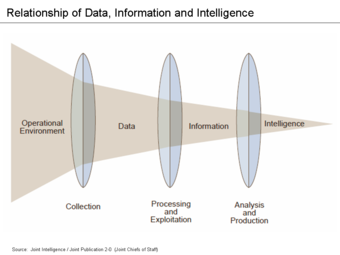
Analyzing the Operational Environment
This image shows how information from the operational environment translates into meaningful data, information and ultimately intelligence for decision-making.
How to be Analytical
Strong analytical skills are as much a developed competency as they are a perspective. Pursuing objective, fact-based decision-making and data-driven conclusions requires a commitment to an analytical mentality. Pushing gut feelings and intuition into the background in favor of framing issues through analysis is a constant struggle in nearly every organization. It is a critical role of management to ask the right questions and align employee behavior with analytical thinking.
Depending on the particular role, industry, organization and objectives, a manager may use one or more of the following analytical models to frame tactical and strategic questions:
- Decision analytics – Using data-driven models and visualizing outcomes of specific organizational behaviors can enable managers to visualize the various outcomes of different strategic approaches.
- Descriptive analytics – Collecting historical data from reporting, scorecards, clustering and various other sources of information, managers can underline trends and identify opportunities and/or risks.
- Predictive analytics – Leveraging statistical models and machine learning, managers can predict future outcomes with varying degrees of statistical confidence.
- Prescriptive analytics – Using optimization and simulation, managers can produce recommended decisions through analytical modeling.
Domains of Analytics
- Behavioral analytics
- Cohort Analysis
- Contextual data modeling
- Enterprise Optimization
- Financial services analytics
- Marketing analytics
- Pricing analytics
- Retail sales analytics
- Risk & Credit analytics
- Supply Chain analytics
- Talent analytics
- Transportation analytics
- Customer Analytics
More Important Now Than Ever
In the current technological environment of big data, analytics has never been more relevant and central to the organization. With endless data available, it is easier than ever to derive advantage or make substantial mistakes in digesting this data. Indeed, utilizing analytics incorrectly can be just as disastrous as not using it at all! In a world with this much data, maintaining objectivity and refraining from cherry-picking to prove one’s opinion is a very important skill.
Managers must be owners not only of the decisions they make, but the validity of the process in which they make them. Analytics is the core skill set required for success in this domain, arguably the most important facet of management.
8.5.6: Sensitivity to Human Relations
Good managers have an innate sensitivity to the needs of the people they manage, and a highly developed emotional intelligence.
Learning Objective
Integrate emotional intelligence and human resource needs into the broader field of management
Key Points
- Management is primarily the task of aligning internal resources to create efficient production processes. These resources are often human resources with complex emotional needs.
- Strong managers have an innate sensitivity to human resource needs, which is enabled by a high level of emotional intelligence (EQ).
- EQ can be defined in a variety of ways. Central to EQ is communication, courtesy, interpersonal skills, positive attitude, and a strong sense of teamwork.
- To create a comfortable working environment for employees, managers should focus on motivating, setting goals, delegating and communicating effectively.
Key Term
- Interpersonal skills
-
The competencies related to human interaction, such as social skills, communication, and emotional intelligence.
Management is a functional discipline that requires a wide variety of skill sets, including organizational skills, technical skills, and people skills (or ‘soft skills’). Effective management is often centered around people skills, as the resource being managed is primary the effort of human resources.
As a result, managers who are sensitive to human resources are much more likely to be successful in a leadership role.
Soft Skills and Emotional Intelligence
The skills required to lead from a human sensitivity perspective are often referred to as soft skills or EQ (emotional intelligence). According to a research done at Eastern Kentucky University, soft skills can be summarized as the following ten attributes:
- Communication – Speaking, writing, presenting, and listening
- Courtesy – Showing appropriate respect and pleasantries when dealing with others
- Flexibility – Both adaptable and teachable, good managers can fill the unique needs of each employee they manage through changing their own habits
- Integrity – Understanding the ethical implications of decisions is integral to success
- Interpersonal skills – This is an extensive list of characteristics involving social ability, friendliness, sense of humor, patience, etc.
- Positive attitude – A confident and upbeat personality tends to trickle down through work groups
- Professionalism – Reliability and professionalism go hand and hand, and showing a strong sense of professionalism can emotionally reassure employees
- Responsibility – A willingess to take credit for the team’s mistakes and a willingness to give the team credit for their successes is a key component of responsible management
- Teamwork – Mangers must be collaborators, capable of filling the many roles required in a team
- Work ethic – Finally, management is hard work, and strong work ethic sets a good example.
As you can see here, the vast majority of these skills involve integrating with human resources. High performing managers are sensitive to the needs, emotions, perspectives ,and well-being of the individuals they are managing.
How to Manage Sensitively
With the above core skills in mind, managers with a strong sense of human resource sensitivity focus on managing people via the following four phases:
- Motivating – Understand what your employees are good at, and what they enjoy. Let them know they are appreciated for their skills and attitude and ensure they have everything they need to succeed in their role.
- Setting Goals – Create agreement among the team regarding direction, and identify practical objectives that won’t overburden or intimidate team members. Offer feedback, and receive feedback in turn. Ensure that feedback maintains a positive note.
- Delegating – Managers must take on the functional role of delegation. This simply means dividing tasks among the work group, and letting each individual know what is expected of them and how they will contribute. Give employees credit for their successes, and as a manager it is on you to take responsibility for any failures.
- Focus on Communication – Communicating well and avoiding misunderstandings will save time and stress. Make sure tasks are clear and feedback channels are open. Listen carefully and clarify what you’re hearing. Take an active interest in your employees.
Through focusing on these core human relations activities while managing, employees are likely to have the clarity, confidence, and commitment required to succeed in the workplace.
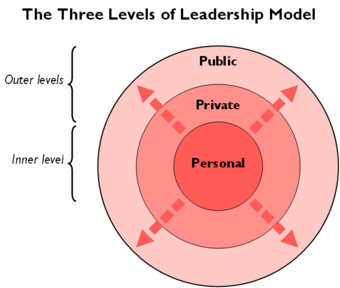
The Three Levels of Leadership
Much of a leader’s responsibilities lie in managing and motivating externally. This is to say that leaders are not only defined by their internal competencies, but more importantly by their ability to translate these competencies externally.
